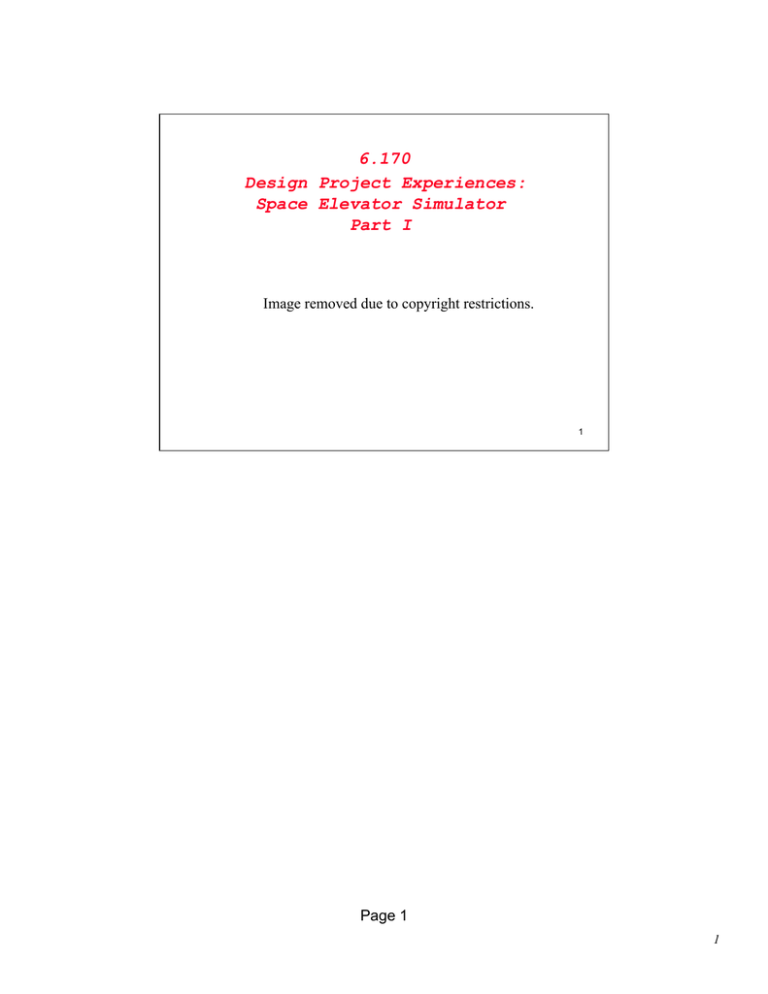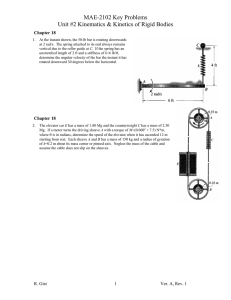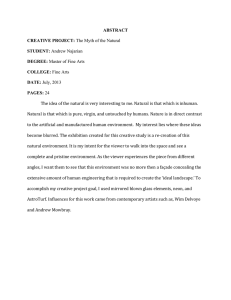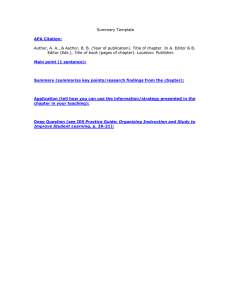Document 13512496
advertisement

6.170
Design Project Experiences:
Space Elevator Simulator
Part I
Image removed due to copyright restrictions.
1
Page 1
1
Space Elevator
• Elevator 60,000 miles high to carry cargo into
space
• Sci-fi solution
Image removed due to copyright restrictions.
•
Capture asteroid
•
Place in earth orbit
•
Mine asteroid for its
carbon
•
A large cable is
extruded both upward
and downward till
complete
2
Page 2
2
Building a Space Elevator
• Arthur C. Clarke, “The Fountains of Paradise”,
1978
– Invents super strong monofilament carbon fibers
and builds a cluster of cables (!)
– Built a solid tower around the skeleton cables (??)
– Ran the tower past geosynchronous orbit to a large
counterweight
• With the invention of the carbon nanotube (1991),
the concept is moving from science fiction to the
fringes of reality
• Edwards and Westling, “The Space Elevator”,
2002 -- NASA-funded feasibility study.
3
Page 3
3
“Realistic” Space Elevator
• Spacecraft launched into
geosynchronous (35,000km) orbit.
• Spacecraft lowers thin ribbon toward
ground, and moves outward to keep it
from falling, eventually ending up at
100,000 km.
Image removed
due to
copyright restrictions.
• When ribbon reaches earth, it is tied to a
base station (floating platform off the
coast of Ecuador).
• To strengthen and widen the initial
ribbon, climbers, powered by lasers
from earth stitch on additional ribbons
for 2½ years.
• Ribbon is 3 feet wide and supports 13
tons in completed elevator.
4
Page 4
4
Why a Space Elevator?
• Large orbiting solar collectors for power
generation and transmission to earth
• Manned space station at
geosynchronous orbit
• Manned Mars exploration and
colonization
Chronological order
• Inexpensive delivery of satellites to
space
• Future vacation facilities in space
5
Page 5
5
Summer Project
• Obtain first-hand experience with 6.170-like
project, a space elevator simulator
• People & Schedule
– Dwaine Clarke, Srini Devadas, Blaise Gassend,
Daihyun Lim
– Six weeks of off-and-on work to produce
rudimentary [and buggy] implementation
– Project finished up [and debugged] by Lee Lin
and Matt Notowidigdo
6
Page 6
6
Functionality
• Simulate and view space elevator dynamics
• Main objects are Central planet, cable,
counterweight, climber
– Cable modeled as masses and springs
• Main forces are gravitational, centrifugal and
coriolis
– Coriolis is an inertial force acting on an object
that moves within a rotating coordinate system.
• Different views:
– Text file
– Swing
– Java 3D
7
Because of Coriolis force, the object does not actually deviate from its
path, but it appears to do so because of the motion of the coordinate
system.
Page 7
7
Our First MDD
GUI
Displays World
Invokes TimeSim
methods
World
Creates static
parts of SimStruct
SimStruct
Displays
SimOut
Dynamically
updates
and reads
SimStruct
TimeSim
Creates SimOut
objects
SimOut
8
The World consists of all of the elements in the Space Elevator and
space. This includes the Central Planet (earth), the cable, the climber
and the counterweight, at the minimum.
You can add other planets and also describe the cable as a collection
of cables.
Simstruct is the basic simulation structure that is created by World and
TimeSim. World objects turn into SimStruct objects. For example, a
cable may be turned into a collection of masses and springs.
TimeSim incorporates methods to simulate World elements and
includes the equations that model the physical forces. TimSim
continually updates SimStruct during simulation. The output of
TimeSim, that is, the statistics of the simulation is SimOut. Note that
the positions and velocities of World elements are part of SimStruct.
SimOut corresponds to statistics gathered during simulation, for
example, the maximum force, minimum force, etc.
Page 8
8
A Little More Detail …
World
Editor
Draw
Adds World
components
SimEditor
Invokes TimeSim
methods
Displays World
World
Displays
SimOut
SimStruct
TimeSim
Draw calls methods to access World’s data and draws the
“World”
What if we want to extend the “World” ?
9
The problem is that it is not very extensible if we want to add different
components to World, say the Moon, in addition to Central Planet,
cable, etc.
Page 9
9
Our Second MDD
Main
Startup,
refresh
Startup,
refresh
Editor
Draw
World Calls Draw methods (Swing)
Constructor
SimOut
Viewer
Invokes TimeSim
methods
TimeSim
SimStruct
Dynamically
updates
and reads
SimStruct
Calls
Draw
methods
Displays
SimOut
Creation,
mutation
SimOut
10
Let’s have objects in the World call Draw methods and draw
themselves. This makes for a more extensible world because we can
add modules and add their draw methods.
In general, if you have a module that is required to continually change
within the lifetime of the software application, then it is a good idea to
reduce the dependency ON that module.
You can make the extensible module depend on other less frequently
changing modules.
Similarly, we will have objects in World call the simulator methods to
simulate their dynamics.
In this MDD it is clear that World is the central module/ADT. World and
Editor are tightly coupled since the World will need to invoke Editor
methods to edit its objects, and the editor will need to invoke World
methods to update the objects with new ones, or update object
positions.
World objects call methods in Draw and TimeSim to draw or simulate
themselves.
Page 10
10
Viewer Functionality
Main
Editor
World
Draw
(Swing)
SimOut
Viewer
Render
(Java 3D)
Today, we’ll focus on the “viewer” functionality as opposed to
simulator functionality.
11
We’ll focus on the Viewer for this lecture. Note that I have added the
Java 3D viewer here. We will not be talking about Java 3D in this
lecture, but I added it to show that one can have multiple views of the
same information.
Page 11
11
Class Hierarchy for Viewer
abstract class
World
module
World
Structure
World
Contains
WorldStructure,
Simulator
World
Element
Array of
instances of
world elements
Cable
Editor
module
Cable
Editor
Draw
module
Editor
Planet
Illustrator
Cable
Ilustrator
Planet
Editor
Planet
Ilustrator
12
Let’s look at the class hierarchy for the viewer part of the Space
Elevator (SE) simulator.
We have a World class, a WorldStructure class and an abstract
WorldElement class. A World object contains a WorldStructure object
and a Simulator object.
WorldElements can be instantiated as planets, cables, masses, and
connectors (springs).
We have an Editor class that is subclassed by the editors for various
WorldElements, so we will have a PlanetEditor, CableEditor, etc.
Similarly, we have an WorldIllustrator (Drawer) class that is subclassed
by the various WorldElement illustrators. So we will a PlanetIllustrator,
a CableIllustrator, etc.
Page 12
12
Multiple Views
• Want to support multiple views
Editor view
Simulation view
3-D rendering
Image removed due to copyright restrictions.
• Views have to be consistent through simulation!
– Change in one view should immediately
propagate to another
13
Editor view has static parameters for WorldElements such as cable and
planet. These static parameters are the material constants of the
cable, and initial starting position, etc. If there is a change in the
parameters during simulation, for example, because of a break in the
cable, then the simulator should immediately use the changed
parameters.
The simulator view shows the changing positions and velocities of the
WorldElements during simulation.
The numbers shown the simulation view are rendered using Java 3D in
the 3D view.
Page 13
13
Simple Example of Multiple Observers
interface WorldElementViewer {
void update(property, newvalue);
}
class 2DElmViewer implements WorldElmViewer {
void update(prop, nval) {
// Swing update code
}
}
abstract class WorldElement {
ssv = new 2DElmViewer( );
…
ssv.update(property, newvalue);
}
What happens if we want to add a viewer ?
14
Answer on next slide!
Page 14
14
Multiple Observers
interface WorldViewer {
void update(property, newvalue);
}
class 3DElmViewer implements WorldElmViewer {
void update(prop, nval) {
// Java 3D update code
}
}
abstract class WorldElement {
…
ssv = new 2DElmViewer( );
psv = new 3DElmViewer( );
…
ssv.update(property, newvalue);
psv.update(property, newvalue);
}
Need to change all
methods that call update
on the old viewer to also
update new viewer
15
Page 15
15
Observer Design Pattern
Rather than hardcoding which views to update, the
WorldElement can maintain a list of observers that need to
be notified when its state changes
abstract class WorldElement {
…
List<WorldElmViewer> observers =
new ArrayList<WorldElmViewer>( );
…
for ( WorldElmViewer v: observers) {
v.update(property, newvalue);
}
}
16
The Observer design pattern is a behavioral pattern that is described in
the Design Pattern Lecture 18 notes.
Page 16
16
Observer Design Pattern (contd.)
In order to initialize the observers the WorldElement class
should provide at least two additional methods
abstract class WorldElement {
…
void register(WorldElmViewer viewer) {
observers.add(viewer);
}
boolean remove(WorldElmViewer viewer) {
return observers.remove(viewer);
}
…
}
Glossed over details, e.g., how update’s are actually generated
17
Page 17
17
java.beans Support
EventListener tagging interface (no methods)
interface PropertyChangeListener extends EventListener {
void propertyChange(PropertyChangeEvent evt); }
class PropertyChangeEvent
Provides constructor with old and new values
corresponding to the event
Provides methods getOldValue, getNewValue
class MyLis implements PropertyChangeListener { .. }
class PropertyChangeSupport
Provides methods to add listeners, remove listeners,
generate all listeners and fire an existing
PropertyChangeEvent to any registered listeners
18
9,���3� �39071,.0 �,8 34 209�4/8� �98 43�� 5:75480 �8 94
,��4� 9�0 :80 41 �389,3.041 �3 , 9�50 �36:�7��
if (obj instanceof EventListener) . . .
A bean is a component based on the JavaBeans architecture.
Page 18
18
PropertyChangeSupport Class Methods
PropertyChangeSupport(Object source)
Constructs a PropertyChangeSupport object.
void addPropertyChangeListener(PropertyChangeListener
listener)
Add a PropertyChangeListener to the listener list
void firePropertyChange(String name, int old, int new)
Report an int bound property update to any registered listeners.
PropertyChangeListener [ ] getPropertyChangeListeners()
Returns an array of all the listeners that were added to the
PropertyChangeSupport object with addPropertyChangeListener().
void removePropertyChangeListener( PropertyChangeListener
listener)
Remove a PropertyChangeListener from the listener list.
19
PropertyChangeSupport is a class in the java.beans package. It
provides support to update listeners when a particular property
changes.
Page 19
19
Pictorially …
MDD
Object Model
!
EventListener Tagging interface
(no methods)
MyProperty
!
Object
!
!
PropertyChange Void propertyChange(
Listener
PropertyChangeEvent evt)
Property
Change
Support
addPropertyChangeListener(…)
MyLis
implements propertyChange()
to update internal state
of listener
PropertyChange
Event
Constructor
PropertyChangeEvent(…)
getOldValue(), getNewValue()
removePropertyChangeListener(…)
firePropertyChange(…) {
Construct PropertyChangeEvent
object evt
On all registered listeners,
e.g., MyLis, call
MyLis.propertyChange(evt)
20
Page 20
20
Usage
class MyProperty {
private Object val;
PropertyChangeSupport support;
MyProperty(Object ival) {
val = ival;
support = new PropertyChangeSupport(this); }
void setValue(Object nval) {
support.firePropertyChange(“value”, val, nval);
val = nval; }
public void addListener(PropertyChangeListener Ln) {
support.addPropertyChangeListener(Ln); }
public void removeListener(PropertyChangeListener Ln) {
support.removePropertyChangeListener(Ln); }
}
21
Note the use of composition and forwarding in MyProperty. You do not
want to extend PropertyChangeSupport, since you are implementing a
property which is not a true subtype of PropertyChangeSupport.
Page 21
21
Demonstration
• Today, a simple demonstration of editing and
viewing functionality (with multiple views)
• Tomorrow, more implementation details, Java
3D, and a demo of all existing functionality
22
Page 22
22




